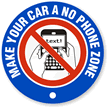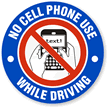Does voice-activated texting curb distracted driving dangers?
Distracted driving is a well-publicized issue, but it’s surprising how much of a problem it remains. I recall a time when my friend, an aspiring doctor, was driving me. At nearly every stop light, she would text furtively at her phone. I was surprised that such a bright person would still text and drive, and one wrong moment of inattention diverted from the road to a particularly engrossing text or a phone fumble could have led to disaster. Countless people in the U.S. have been in the same situation, so both phone manufacturers and drivers have tried to find ways around it. Enter voice-activated texting (speaking into a phone to send a text). So, does voice-texting help keep drivers better focused?

Contrary to popular belief, voice texting is not a good alternative to manual texting.
Actually, it’s just as bad. “Anything that takes your attention away from the task of driving is a distraction,” said Buel Young, an employee at the Maryland Motor Vehicle Administration. “Distracted driving is a hazard on the roadway.” An experiment was conducted with 43 drivers set to drive a closed course:
• The first time they drove the course, they drove the wheel without texting.
• The second time, they drove with a voice to text application on an Android phone.
• The third time, they used a Siri app on an iPhone.
• The last time, they sent texting the old-fashioned way with their fingers.
Researchers from Texas A&M’s Transportation Institute measured the time it took each driver to complete the texts and the amount of time it took them to react to a light that came on at random during the exercises. The test meant that the driver had to hit a button on the dashboard when they saw the light, similar to reactions drivers need to make in order to look at the road or swerve to avoid a pedestrian or obstruction.
Researchers found that regardless of which way they texted, manually or with voice-activation, response times were more delayed than without texting at all. In fact, finger-texting took less time. During voice texting, the driver felt like they had to proofread the texts before allowing voice-to-text applications to send them. In any case, voice activated texting takes drivers’ minds off the road.
A driver is 23 times more likely to crash if texting while driving. It’s imperative to spread messages that cell phones must be put away while driving. It’s easy to pull over to the curb or find a highway restaurant stop to take an important call, or ignore an unimportant call for a few minutes. Perhaps voice-activated texting would be fine elsewhere: a stroll in the park or dining outside, but not behind the driver’s seat.
You know that friend who gets text-happy on car trips? Try giving them a personalized sign. Maybe they’ll think it’s funny, maybe they’ll get offended, but you know in the end it’s ultimately what’s best for them.

Gently remind your text-happy friends you care. View this custom sign here.
View more texting and driving signs here. If you’re a teacher or parent, learn how you can get two free distracted driving signs for your school!















